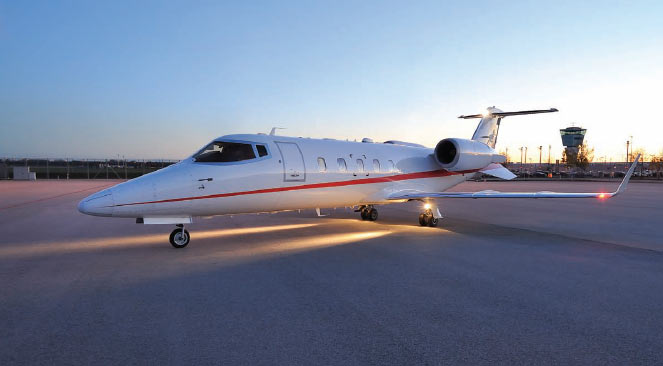
How many people realize how commonly airlines actually own just a few aircraft, holding 80 percent or more of their liveried fleet under a five- or ten-year operating lease? GOALis a joint venture company owned by KGAL GmbH & Co. (KGAL) and the German national airline, Deutsche Lufthansa AG (Lufthansa). These are a couple of the most experienced players in the airline industry; the Lufthansa group’s fleet of aircraft is the third-largest in the world, and KGAL has financed well over 300 aircraft in its time. “GOALcan offer clients a unique combination of resources,” says managing director Michael Radunz, “KGAL’s 40 years of in-depth involvement in the structured asset finance sector and Lufthansa’s five decades of operational experience in the aircraft industry.”
From KGAL’s perspective, it suited it well to partner with a professional asset manager that knew the market and how to maximize the value of an asset over the term of the funding, whether through public offer or private equity.
When GOAL was founded in 1998, Radunz says, aircraft leasing was already an important activity for Lufthansa. The airline had a business unit, Lufthansa Leasing GmbH,that was provided financial leases to the Lufthansa group and to a number of other airlines, and that business was doing very well. In addition, Lufthansa was active in the operating lease market since 1993. However, Lufthansa wished to put some distance between its brand and these leasing activities. “The task then was to find a partner willing to work with an operating lessor, and because KGAL had already done business with the group’s leasing arm, it was a natural choice.”
The business today is led by joint managing directors—Radunz with ten years’ experience at Lufthansa and Christian Schloemann on the financial side. The business case for its establishment was to optimize the use of Lufthansa’s leased assets and to take advantage of market cycles. “The best example I can think of would be five Airbus A310-300s that Lufthansa wanted to sell in 2003. There was a downturn in the market at that time, and nobody wanted to pay a sensible price, so those planes were transferred to us. We were able to place the planes out on five-year leases to Air Transat, Canada, and then sell them a couple in 2008–09 when the market had picked up. One of the main objectives of GOAL is to take advantage of cycles in the market and decide precisely the best moment to sell the aircraft.”
The sale-and-leaseback model appeals to airlines for different reasons, but typically it is a way for companies to reduce their capital assets while gaining some of the advantages of outsourcing. There’s a lot of administration, document management and recording associated with owning an aircraft, and GOAL has developed its own system for dealing with that, says Radunz. “Every aircraft used to be accompanied by around 30 boxes of documents, tracing the provenance of every replacement part that has gone into it as well as recording its maintenance history in detail. Sometimes when we acquire older aircraft the documentation is not in electronic format—they just hand us the boxes. We had to have an intelligent way to manage all this information. We used our own IT system for a while, but as our portfolio grew above 15 aircraft, that wasn’t really up to the job, so we scanned the market.”
Several systems existed. However, it happened that the parent company’s technical arm, Lufthansa Technik AG, was developing a system in collaboration with the Swiss IT developer Open Connect that suited GOAL’s needs much better. “We bought a license and adapted the software to the particular needs of a lessor. One of our key selling points when we go to the market is that we keep track of the assets very closely with this system,” Radunz adds. “The software system is very transparent; our clients can import their monthly flight hours and cycles into the system in a very convenient way.”
If you look at the list of services offered by GOAL, it’s clear that its objective is to be a one-stop shop for its clients. However, each has very different needs according to its size and how long ago it was established. Apart from information management, which safety and international standards demand, insurance is a frequently used service. Some others, like training and catering support, are less often demanded. When they are, though, GOAL can simply make the necessary introductions to the relevant Lufthansa group subsidiaries.
The company’s terms of reference require it to have a viable return on investment. Acquisitions must have a lease agreement in place or some other exit for investors such as a “part-out” opportunity, by which an older aircraft is bought, valuable systems like the engines or landing gear removed and resold, and the airframe finally scrapped. The risk has to be a manageable one, he says, and that is also why almost all of GOAL’s client airlines are in Europe—basically, the German investors are reluctant to put their money into a package with an airline they don’t know well.
The first deal handed over to GOAL involved two Lufthansa Boeing 737-300 aircraft that Lufthansa had sold and leased back in 1998. This was followed in 2000 by two A310-300s owned by Lufthansa and already leased out to Kenya Airways and Air Afrique. Two 737-400s were provided to the Italian carrier Air One under a long-term agreement, then the company moved into new territory with the sale, leaseback and financing of eight Bombardier CRJ 200 regional jets for Eurowings, a Lufthansa subsidiary.
The strategy going forward is to find new aircraft transactions—not so easy in the present climate, he says. “We’re looking at narrow-body transactions involving planes like the Boeing 737 NGs or Airbus A320 family.”
Meanwhile, it seems there will be no lack of new opportunities for GOAL in the wake of a contract it is currently executing for the German air force via Lufthansa Technik. In December 2007 it was asked to manage the acquisition, fitting out and commissioning of four Bombardier Global 5000 jets. “We’re very proud to have been selected by Lufthansa Technik to purchase aircraft on behalf of the German government,” says Radunz. “This is a big step for a small company like ours.”
The first plane has already been certified “in green,” ready for fitting out, and the rest will follow later this year in time for delivery in the second half of 2011. The contract could well lead to further projects for government and corporate entities looking to acquire executive jets, he believes.













